Jul 21, 2015 | coin design, coins, commemorative, commentary, dollar, gold, US Mint
What is going on at the U.S. Mint? For an organization whose actions are micromanaged by law seems to be finding a way to get around those rules to make some real questionable decisions.
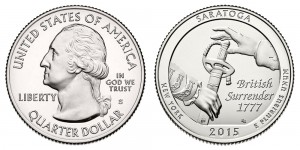
2015-S Saratoga National Historical Park Quarter
Just before the release of the S-mint quarters, the U.S. Mint changed its branding and changed the design of the Presidential $1 Coin Cover. Those of us who collect the coin covers now have two different formatted designs that shows when you show your 2010 Abraham Lincoln cover followed by the 2011 Andrew Johnson cover. And the change puts a thick black bar across the bottom forcing the portrait to be reduced making it an ugly design.
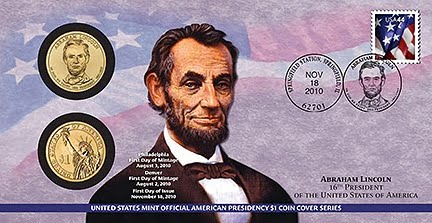
2010 Lincoln First Day Cover (before branding)
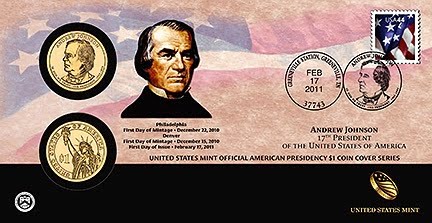
2011 Andrew Johnson First Day Cover (after branding)
Although I love the reverse proof coins and do not think including them in special sets, such as the 2015 Reverse Proof Roosevelt Dime as part of the 2015 March of Dimes Special Silver Set, but there are persistent rumors of a Presidential dollar reverse proof set. Why add a reverse proof set in the middle of a series? What is the U.S. Mint thinking? Adding a reverse proof to an existing series is as wrong as the S-mint national parks quarters.
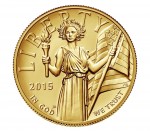
2015 American Liberty High Relief Gold Coin
Look at some of the past images of Liberty and they have a stronger look. Two of the most famous by Augustus Saint-Gaudens and Adolph A. Weinman has a striding Liberty that shows character. George Morgan’s Liberty had a regal look and Anthony de Francisi’s Liberty on the Peace dollar is just a marvel of beauty. This image is so uninspiring that I would buy the coin only because it is the first year of issue and has some investment potential. Otherwise, if I were to invest in 24-karat gold coins I would continue to buy the American Gold Buffalo.
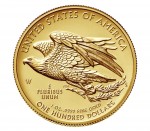
2015 American Liberty High Relief Gold Coin Reverse
I know that the designs were approved by the Citizens Coinage Advisory Committee and the U.S. Commission of Fine Arts. But, as usual, their motivations and sense of design is really in question. Maybe it is time we drop one of these committees and streamline the process.
Expanding collecting options from the U.S. Mint is good for the hobby. However, adding options to existing series and ugly coins should be discouraged.
Saratoga Park quater image courtesy of
USACoinBook.comAll other images courtesy of the U.S. Mint.
Jul 1, 2015 | coins, commemorative, commentary, legislative, policy
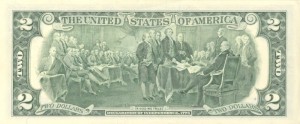
Reverse of the $2 Federal Reserve Note features an engraved modified reproduction of the painting The Declaration of Independence by John Trumbull.
On June 11, rather than let Jefferson continue his draft, the Continental Congress elected the Committee of Five to write the full document. John Adams, whose role in the Continental Congress would be that of the Majority Leader today, was a member of the Committee of Five but insisted that most of the writing be done by Jefferson. The other members of the Committee of Five were Ben Franklin, Roger Sherman, and Robert Livingston.
The committee presented the document to the Continental Congress on June 25. For the next seven days, the document went through the first ever mark-up session where members applied their edits to the document. Debate began on July 1 and by July 2 everyone who wanted to speak has their say before the vote. With each delegation allowed one vote, the final tally was 9 in favor of independence, 2 against (Pennsylvania and South Carolina), and one abstention (New York, their delegation did not have their legislature’s authority to cast a vote).
But if you thought that this was the end of the debate, you failed to remember that this was the beginnings of congress! The vote was conditional on Jefferson revising the document before it was adopted. The rewrite was completed and presented the final copy to the Continental Congress on July 4, 1776 where it passed with the same vote. Adams felt that July 2 should be considered Independence Day. A combination of the day that the text was adopted and what we would consider in today’s environment to be a clerical error, the Declaration of Independence was signed (on August 2, 1776) saying that independence was declared on July 4, 1776.
The moral of this story is that no matter how ridiculous the bill or idea, it is not law until the final version of the bill is approved and signed.
Congress had a busy June with regard to coin-related legislation. The bills that saw action were as follows:
H.R. 2722: Breast Cancer Awareness Commemorative Coin Act
Sponsor: Rep. Carolyn Maloney (D-NY)
• Introduced: June 10, 2015
• Referred to the House Committees on Financial Services and Budget
Track this bill at https://www.govtrack.us/congress/bills/114/hr2722
H.R. 2726: Apollo 11 50th Anniversary Commemorative Coin Act
Sponsor: Rep. Bill Posey (R-FL)
• Introduced: June 10, 2015
• Referred to the House Committee on Financial Services
Track this bill at https://www.govtrack.us/congress/bills/114/hr2726
H.R. 1698: Bullion and Collectible Coin Production Efficiency and Cost Savings Act
Sponsor: Rep. Bill Huizenga (R-MI)
• Introduced: March 26, 2015
• Passed the House of Representatives on June 23, 2015 by voice vote
• Received in the Senate on June 24, 2015 and referred to the Committee on Banking, Housing, and Urban Affairs
Track this bill at https://www.govtrack.us/congress/bills/114/hr1698
H.R. 893: Boys Town Centennial Commemorative Coin Act
Sponsor: Rep. Jeff Fortenberry (R-NE)
• Introduced: February 11, 2015
• Passed the House of Representatives on June 23, 2015 by voice vote
• Passed the Senate on June 25, 2015 by unanimous consent
• Presented to the President on June 26, 2015
Track this bill at https://www.govtrack.us/congress/bills/114/hr893
H.R. 2906: To require the Secretary of the Treasury to mint coins in recognition of the 50th anniversary of the Texas Western College National Collegiate Athletic Association men’s basketball championship.
Sponsor: Rep. Beto O’Rourke (D-TX)
• Introduced: June 25, 2015
• Referred to the House Committee on Financial Services
Track this bill at https://www.govtrack.us/congress/bills/114/hr2906
May 25, 2015 | celebration, commemorative
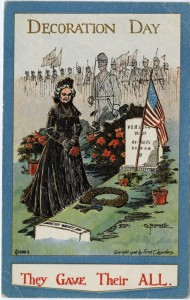 The first recorded organized public recognition of the war dead occurred on May 1, 1865 in Charleston, South Carolina. On that day, Freedmen (freed southern slaves) celebrated the service of the 257 Union soldiers buried at the Washington Race Course (now Hampton Park). They labeled the gravesite “Martyrs of the Race Course.” African Americans continued that tradition and named the celebration Decoration Day.
The first recorded organized public recognition of the war dead occurred on May 1, 1865 in Charleston, South Carolina. On that day, Freedmen (freed southern slaves) celebrated the service of the 257 Union soldiers buried at the Washington Race Course (now Hampton Park). They labeled the gravesite “Martyrs of the Race Course.” African Americans continued that tradition and named the celebration Decoration Day.
Southern states began their own commemoration to honor their soldiers who died during the war. No specific date was used but occurred in late April through June. By 1880, there was a more organized Confederate Memorial Day. These celebrations honored specific soldiers to commemorate the Confederate “Lost Cause.” By 1913, a sense of nationalism saw a commemoration of all soldiers that have died in battle.
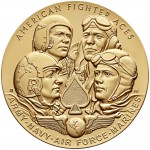
American Fighter Aces Bronze Medal
The modern Memorial Day is a holiday celebrating the lives of those sacrificed in defense of the United States and its ideals at home and abroad. Today, we honor the memories of those who paid the ultimate sacrifice so that I can write this blog and you can read it.
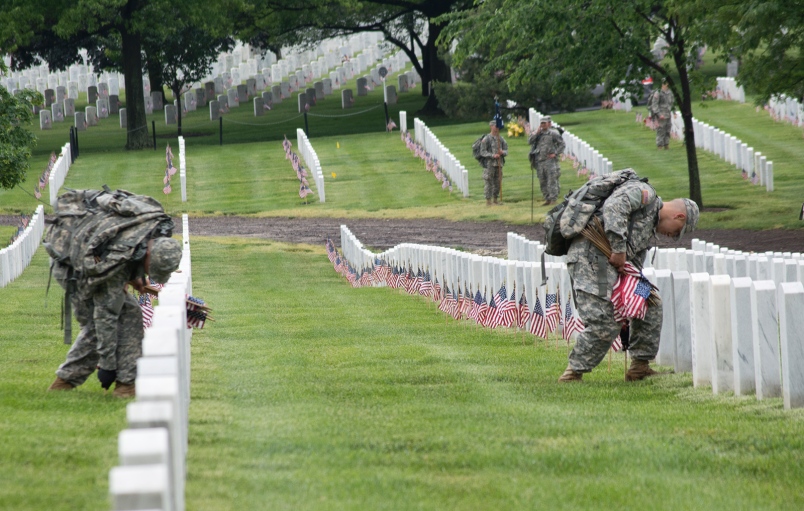
Members of The Old Guard place American flags at headstones at Arlington National Cemetery during Flags-In on May 21, 2015.
May 14, 2015 | Canada, coins, commemorative, gold, nclt, silver
Eh… What’s up, doc?
Hey bub… did ya hear dat de Royal Canadian Mint is going Looney Tunes?
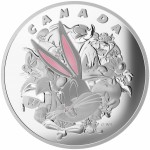
$250 Looney Tunes Silver Kilo Reverse
I will admit to having grown up watching Bugs, Daffy, Porky, Tweety, and all of their friends on the weekend morning cartoons. I spent many mornings in my bedroom before my parents woke up watching on an old black and white television wondering if Wile E. Coyote would ever catch the Road Runner? Would Sylvester ever learn that he should not eat Tweety Bird? Or will Pépé Le Pew ever figure out why he could never find a girl to go with him to the casbah? Of course, at that age, I didn’t know what the casbah was!
I guess I also have to admit that I am intrigued by some of these coins. Not the ones that seem to be enameled for the design because I have this thing about using paint for the design of the coin. But there are some coins that are going to be really engraved coins that are somewhat affordable. Apparently, if I examine my own preferences, I do not mind enhanced color that enhances the designs but not just splashing paint on the metal disks.
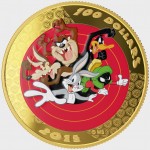
$100 Looney Tunes 14-karat Reverse
For those not familiar with the Royal Canadian Mint’s “20 for $20” program, they provide a limited mintage silver coin with a $20 face value for $20 (note that all prices are in Canadian dollars). These coins are 7.96 grams of .9999 silver and available for direct purchase to buyers in Canada and the United States.
As I type this $20 Canadian is worth $16.49 USD. A U.S. resident buying directly from the Royal Canadian Mint will have their credit card charged in Canadian dollars. Your credit card company will pay the Royal Canadian Mint at the rate at the time of the transaction plus an exchange fee. Exchange fees differ between credit card issuers.
Other options include:
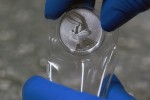
Bugs Bunny $20 Silver coin reverse, part of the Royal Canadian Mint 20 for $20 program
- A $20 “Merrie Melodies” silver coin featuring Bugs Bunny and the gang in a design that is reminiscent of the Looney Tunes’ end credits. The coin is cleverly packaged in a box that mimics the ACME crate.
- A $20 silver four-coin set featuring Bugs Bunny, Daffy Duck and Tweety. If you buy the set as a subscription it will include a free Looney Tunes wrist watch.
- A 14-karat gold Bugs Bunny and Friends coin featuring Bugs Bunny, the Tasmanian Devil, Wile E. Coyote, Daffy Duck and Marvin the Martian. The Royal Canadian Mint claims that there is a “hidden surprise design element” in this coin. If you buy this coin you will also receive an “exclusive” pocket watch.
- Finally, the Royal Canadian Mint will issue one kilo gold and silver coins. The gold coin will have a face value of $2,500 and the silver will have a face value of $250. The design will feature every major Looney Tunes characters. The design of both coins features selective colored enamel applied by hand to Bugs Bunny who serves as the central focal point. He is surrounded by the entire cast of Looney Tunes characters.
As this posting was saved as a draft for the last few days, I have been contemplating what I wanted to do. With my new found nostalgia and admitted mid-life crisis, I look back at the Looney Tunes fondly. Where I grew up, Bugs Bunny sounded like he could have been one of my neighbors! Mel Blanc, who gave Bugs his voice, wasn’t even from New York yet nailed the accent, cadence, and attitude perfectly. I will probably order the Bugs Bunny “20 for $20” silver coin and take some time before I decide on others. if I do decide to do the whole series, I would probably buy the silver $10 coins because they are coins without painted on designs.
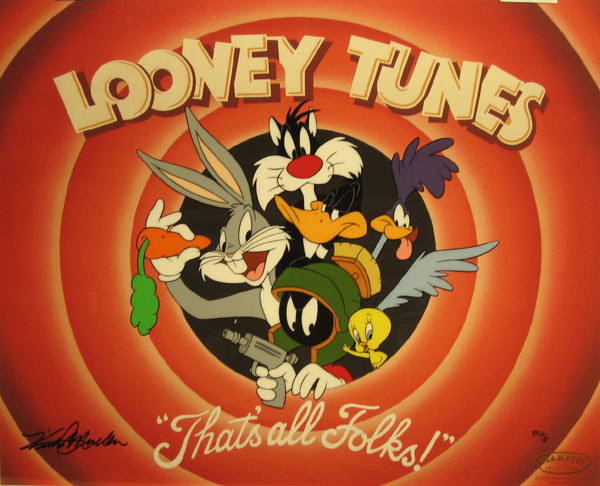
All coin images courtesy of the Royal Canadian Mint.
May 6, 2015 | BEP, coins, commemorative, currency, Federal Reserve, legislative, policy, US Mint
For those of us who are political junkies, April was a relatively quiet month. At least there was something to watch that was more related to the hobby than the usual partisan bickering. Here are the coin and currency-related legislation moving through congress:
S. 925: Women on the Twenty Act
Sponsor: Sen Jeanne Shaheen (D-NH)
• A bill to require the Secretary of the Treasury to convene a panel of citizens to make a recommendation to the Secretary regarding the likeness of a woman on the twenty dollar bill.
• Introduced: April 14, 2015
• Referred to the Senate Banking, Housing, and Urban Affairs Committee
Track this bill at https://www.govtrack.us/congress/bills/114/s925
S. 95: A bill to terminate the $1 presidential coin program
Sponsor: Sen. David Vitter (R-LA)
• Introduced: January 7, 2015
• Discharged from Senate Committee on Homeland Security and Governmental Affairs by Unanimous Consent on April 14, 2015
• Referred to the Senate Committee on Banking, Housing, and Urban Affairs on April 14, 2015
Track this bill at https://www.govtrack.us/congress/bills/114/s95
S. 985: United States Coast Guard Commemorative Coin Act
Sponsor: Sen. Christopher Murphy (D-CT)
• To require the Secretary of the Treasury to mint coins in commemoration of the United States Coast Guard.
• Introduced: April 16, 2015
• Referred to the Senate Banking, Housing, and Urban Affairs Committee
Track this bill at https://www.govtrack.us/congress/bills/114/s985
Apr 15, 2015 | cents, coins, commemorative, currency
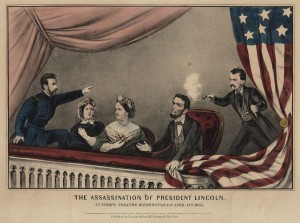
Lithograph depicting Lincoln’s Assassination by Currier and Ives.
Joining the crowd in the room was Surgeon General of the United States Army Joseph K. Barnes, his assistant Charles Henry Crane, Lincoln’s personal physician Dr. Robert K. Stone, and Dr. Anderson Ruffin Abbott the first Black Canadian to be a licensed physician. With Barnes in charge, the examination and treatment proved beyond the capabilities of the medical arts of the time. By 7:22 AM on April 15, 1865, Abraham Lincoln, the 16th President of the United States of America had succumbed to his injuries.
While every president faces their shares of challenges, Abraham Lincoln was challenged with the morality of slavery and the breaking apart of the republic before it reached its 100th anniversary. He was so concerned about keeping the nation together that not only did he have Union troops shoot at what he considered fellow Americans, but he broke laws and violated the constitution in order to keep the country going.
Lincoln is remembered for his debates with Stephen Douglas, the Emancipation Proclamation, Gettysburg Address, his second inaugural address, the Civil War, the Homestead Act, three revenue-based (taxation) acts, and the National Banking Act that lead to the creation of the Bureau of Engraving and Printing. Aside from being the first president assassinated, there are other aspects of his presidency that is not widely discussed. Lincoln was known for either not enforcing laws he did not like or over enforcing laws to silence critics. While he did not condone a lot of the brutality especially from Generals Sherman and Grant, he did not condemn them either. Some historians suggest that his appointment of the young General George B. McClellan after the loss at the First Battle of Bull Run was to use him to manipulate the strategy to be more brutal against the Confederacy.
In a move that would have had any modern president excoriated, Lincoln ignored a writ of habeas corpus issued by Supreme Court Chief Justice Roger B. Taney. Lincoln became incensed with Taney after he authored the controversial Dred Scott v. Sanford decision that Lincoln highly disagreed with. Following the writ, Lincoln and his cabinet ignored Taney, a move that hurt him in many ways. Taney died miserable and poor after a long illness blaming Lincoln for his decline.
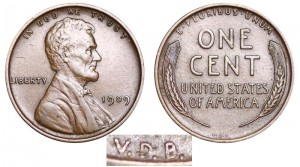
1909-VDB Lincoln Cent
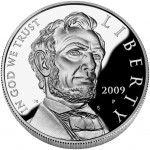
Obverse of the 2009 Abraham Lincoln Commemorative proof coin
At one time there was a trivia question as to the only United States coin with a presidential portrait of a president on both sides of the coin: the Lincoln Memorial cent. If you look carefully in the memorial on the reverse, you can see the statue of Lincoln in the memorial making it the only coin of its time to have this distinction.
Aside from appearing on the current $5 Federal Reserve Note, Lincoln has appeared on notes of 10 different designs and denominations including the fourth issue 50-cents fractional note, $10 Demand Note, $500 Gold Certificate, and a $1 large size silver certificate.

Series 1882 $500 Gold Certificate
In honor of Lincoln, spend at least one of those little copper-coated zinc cents remembering that if it was not for him, that coin might not have existed.
Curier & Ives image courtesy of the Smithsonian Institute.
Image of the 1909-VDB cent courtesy of
USAcoinbook.com.Image of the 2009 Lincoln commemorative dollar courtesy of the U.S. Mint.
Banknote image courtesy of
AntiqueBanknotes.com.
Apr 3, 2015 | coins, commemorative, gold, legislative, silver
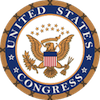 March saw the sales tax come under attack as states are looking to the federal government to lift the restrictions on collecting taxes on interstate sales. The senate re-introduced the Marketplace Fairness Act with lifts the restrictions on all interstate sales, not just those made via the Internet.
March saw the sales tax come under attack as states are looking to the federal government to lift the restrictions on collecting taxes on interstate sales. The senate re-introduced the Marketplace Fairness Act with lifts the restrictions on all interstate sales, not just those made via the Internet.
In March, the Supreme Court ruled that a challenge to Colorado’s so-called “Amazon tax” can proceed in federal court, Justice Anthony Kennedy suggested that that the court should re-examine the physical presence rules. As part of the court’s opinion on the Colorado case, Kennedy wrote that the ruling “now harms states to a degree far greater than could have been anticipated earlier.”
Remember, the overwhelming majority of coin dealers are small businesses. All of these attempts by the states to squeeze every last cent out of you will put a heavy burden on small businesses. If it costs too much for small businesses to manage these sales tax rules it could impact coin shows all over the country.
This one is going to get dicy. stay tuned!
In February, there was only one bill that saw any action:
S. 301: Boys Town Centennial Commemorative Coin Act
Sponsor: Sen. Deb Fischer (R-NE)
• To require the Secretary of the Treasury to mint coins in commemoration of the centennial of Boys Town
• Passed Senate without amendment by Unanimous Consent on March 24, 2015
• Sent to the House of Representatives for consideration (held at the desk) on March 24, 2014
Track this bill at https://www.govtrack.us/congress/bills/114/s301
The following two bills were introduced right before congress adjourned for their spring break and have not been published. While the Coast Guard commemorative is pretty self explanatory, H.R. 1698 is intriguing.
H.R. 1683: To require the Secretary of the Treasury to mint coins in commemoration of the United States Coast Guard
Sponsor: Rep. Joe Courtney (D-CT)
• Introduced on March 26, 2016 (106 co-sponsors)
• Referred to the House Committee on Financial Services
Track this bill at https://www.govtrack.us/congress/bills/114/hr1683
H.R. 1698: To amend design and content requirements for certain gold and silver coins
Sponsor: Rep. Bill Huizenga (R-MI)
• Introduced on March 26, 2016
• Referred to the House Committee on Financial Services
Track this bill at https://www.govtrack.us/congress/bills/114/hr1698
Mar 30, 2015 | Baltimore, BEP, books, coins, commemorative, Red Book, tokens, US Mint
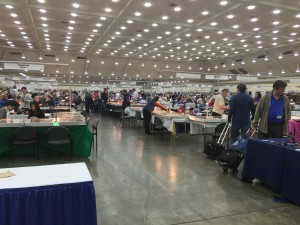 As it does three times per year, Whitman rolls into the Baltimore Convention Center for the Whitman Baltimore Expo. This time, rather than the showing being in Halls A and B it was held in E and F. The new location within the building was not as intuitive to find as walking to the end and Whitman did not do as good of a job as they could have in placing their signs. But for general access, which is was off of South Sharp Street, it provided a little better access than off of West Pratt Street, which is a main artery as it passes in front of the Inner Harbor.
As it does three times per year, Whitman rolls into the Baltimore Convention Center for the Whitman Baltimore Expo. This time, rather than the showing being in Halls A and B it was held in E and F. The new location within the building was not as intuitive to find as walking to the end and Whitman did not do as good of a job as they could have in placing their signs. But for general access, which is was off of South Sharp Street, it provided a little better access than off of West Pratt Street, which is a main artery as it passes in front of the Inner Harbor.
Although there were the same number of booths, the space felt smaller. Lights were brighter since these halls seem to have been converted to using LED lighting—the brighter space made the convention center seem less cavernous. Aisles were not as wide and some of the layout changed, but it seemed to have the same number of dealers. Some of the dealers who had larger spaces did downsize and the one vendor of supplies that is not Whitman did not set up at the show. It is not known if they decided not to attend or were not invited to attend. Since Whitman does not carry all books and supplies, it would be nice if they had another supplier.
On thing I have noticed is that since the death of numismatic book dealer John Burns in early 2014 there seems to be fewer numismatic book offerings at some of the east coast shows. Aside from missing his sharp wit, I was always able to find something a little off-beat or out of the ordinary amongst the books he had for sale. While there was a book dealer at this show, the items were more toward what I would consider ordinary. I hope someone steps in with some interesting items.
As I walked the floor and spoke to many of the dealers (late Friday afternoon), they all said that they were doing well. With the area still a bit chilly and no sports to take over the downtown Baltimore area (home opener for the Baltimore Orioles is on Friday, April 10), visitors to downtown Baltimore had plenty of time to visit. For those of us who like access to a major coin show, it is good to hear. If the dealers are doing well then they will keep coming back. If the dealers come back, the show goes on.
Both the U.S. Mint and Bureau of Engraving and Printing had booths at the show. While the U.S. Mint was showing current products, the Bureau of Engraving and Printing had some historical information. Although it is good to see the U.S. Mint at the show, it might be nice to see some historical artifacts. Since most of the U.S. Mint’s collection was given to the Smithsonian Institute, maybe they can be convinced to bring an exhibit to the show. Having the Smithsonian there would be very different than other shows since they have a different type of collection than the American Numismatic Association, for example.
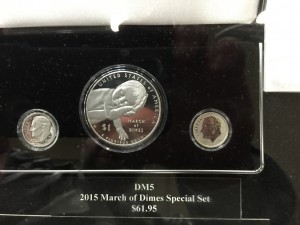
2015 March of Dimes Commemorative Proof set will cost $61.95 when released
Another interesting find was the First Edition of the Red Book Deluxe Edition. While flipping through it at the show, it looks like the Red Book on steroids. There is more information, more detail on pricing, and some other features. A first impression is that it extends the Red Book franchise a bit beyond what they called their Professional Edition. While there is a lot of information, my first impression is that I wish it was more of a cross between the Professional Edition and the Coin World Almanac. Both books have their places, but to combine the pricing and information that is updated yearly (the Coin World Almanac is updated every 10 years) would be a great resource. Hopefully, I will get my hands on one to review.
Finally, no show would be complete with out my one cool find. After walking the floor for a few hours I finally stat at the table of Cunningham Exonumia and had a nice chat with Paul Cunningham while searching for something New York. While I have not given up coins or Maryland Colonial Currency, I seem to be having more fun trying to find tokens and other exonumia from New York City and my hometown of Brooklyn. I have seen Paul at many other shows and have purchased from him. He always has a great selection. For me, I may have exhausted some of his inventory. This time, the pieces he was offering this weekend I already have in my collection.
But it did not stop me from looking. Tokens are very interesting. They are alternatives to money and are more tied to the culture of the community than money. For me, a New York Subway token not only represented a ride on the subway, but it also represents a different part of my life. It makes collecting very person. Although I have a collection of subway tokens I continue to look because you never know what you can find—especially an error.
What I found was a large token with an error. It was sold as the “Large Y” token where the “Y” was supposed to be cutout. Those tokens were used from 1970-1978 and two fare increases starting out at 30-cents in 1970, 35-cents in 1972, then 50-cents in 1975. But what I found is not that token. After examine the token carefully and some others I have, this is an error to the “Solid Brass NYC” Token. Introduced with the 60-cent fare in 1980, the “Y” was part of the raised design and not cutout. The clue as came when examine the obverse (the side that says “New York City Transit Authroity”). Between the “N” and the “C” is the tail of the “Y” but without its top. That tail would not have existed on the earlier tokens because they would have been cut out. Instead, the is a die issue where only the tail of the “Y” on one side was struck.
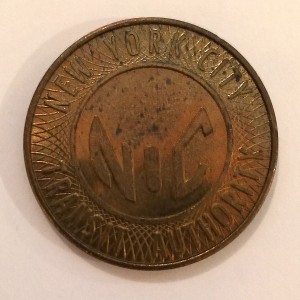
Large Brass “NYC Token” used from 1980-1985 with partial “Y” (obverse)
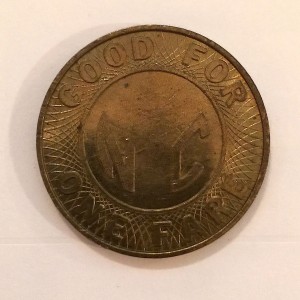
Large Brass “NYC Token” used from 1980-1985 with missing “Y” (reverse)
It might not be the error I expected, but it is an error nonetheless! It also does not make it any less fun or valuable because it will fit nicely in my collection.
If you were not able to make it Baltimore, here are some of the pictures I had taken at the show:
Mar 4, 2015 | coins, commemorative, legislative
 March comes in like a lion in many ways, especially in Washington, D.C. Between the weather, fighting over the budget, or an invitation of a world leader, there has been no shortage of roaring emanating from either end of Pennsylvania Avenue.
March comes in like a lion in many ways, especially in Washington, D.C. Between the weather, fighting over the budget, or an invitation of a world leader, there has been no shortage of roaring emanating from either end of Pennsylvania Avenue.
In the mean time, there was only one bill introduced in February:
H.R. 893: Boys Town Centennial Commemorative Coin Act
Sponsor: Rep. Jeff Fortenberry (R-NE)
• Introduced in the House on February 11, 2015
• Referred to the House Committee on Financial Services
Track this bill at https://www.govtrack.us/congress/bills/114/hr893
Feb 6, 2015 | bullion, coins, commemorative, commentary, gold, policy, silver, US Mint
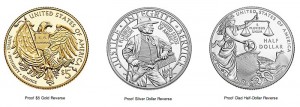
Reverse of the 2015 US Marshal Service 225th Anniversary Commemorative Coins
Time and again, we hear that congress wants the government to save money. They want agencies to reduce costs and build efficiencies. How can agencies save money when members of congress introduce legislation that is counter to those goals?
Congress has been told that the U.S. Mint could save money if they standardized gold coins to 24-karat coins and silver to at least .999 fine quality. Aside from making the coins more attractive to more buyers including investors, the U.S. Mint does not have to pay more for someone to “dirty” the metals to create planchets that contain 90-percent of the metals.
Modern manufacturing methods are geared to process mined metals to create purer metals. In order for the gold or silver to be used to make the 90-percent alloy, it has to be dirtied with another metal, such as copper, before creating the planchets. While it makes the metals cheaper, the process increases the costs per planchet because of the extra work involved.
Congress exasperates this problem by not listening to the U.S. Mint and doing a virtual copy-and-paste from previous bills that says $5 gold commemoratives be made from 90-percent gold and silver dollars from 90-percent silver.
Rather than listening to the U.S. Mint, Rep. Sean Maloney (D-NY), or a non-responsive staffer in his office, did a copy-and-paste of previous commemorative bills to introduce the National Purple Heart Hall of Honor Commemorative Coin Act (H.R. 358) that calls for a 90-percent gold $5 coin and a 90-percent silver dollar.
Regardless of how one feels about the use of commemorative coins for fundraising, if congress is going to authorize a commemorative coin, why not allow the U.S. Mint to take advantage to more efficient manufacturing and stop making them dirty the metals?
It is possible that if the U.S. Mint could create commemorative coins worthy of being on par with investor grade coins, not only could they save money in the manufacturing process which could lower the costs of the coins, but they could sell more coins. If the U.S. Mint sells more coins they could collect more of the surcharges to benefit their intended causes.
If congress really cared about saving money and increasing efficiency in the government, members like Rep. Maloney will look beyond rhetoric and actually do something, no matter how simple it is.
Up next, why some members of congress should leave well enough alone!
Image courtesy of the U.S. Mint.

















 March saw the sales tax come under attack as states are looking to the federal government to lift the restrictions on collecting taxes on interstate sales. The senate re-introduced the
March saw the sales tax come under attack as states are looking to the federal government to lift the restrictions on collecting taxes on interstate sales. The senate re-introduced the 




